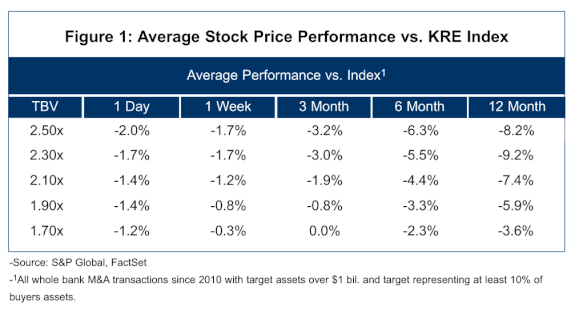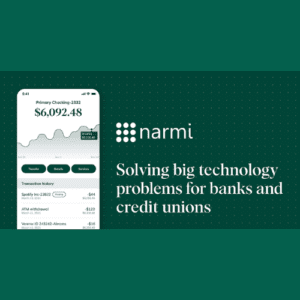Like the Summer Heat, M&A Activity Has Spiked, And In Many Ways Seems Fairly Conventional.
A number of high-profile M&A transactions — like M&T / People’s United; Webster / Sterling; BancorpSouth / Cadence; Old National / First Midwest; and New York Community / Flagstar, along with several others that were less heralded and still others that were more unique (Social Finance / Golden Pacific) – have marked the beginning of what we think is likely to be an M&A wave that could rival any that we’ve seen in the past few decades. In many ways, the deals announced to date aren’t altogether different from what we have been accustomed to seeing in the years prior to the pandemic: larger banks have purchased smaller banks; we’ve seen mergers between similarly sized companies; and, more recently, a few branch transactions. Along with the subsiding of the pandemic and resultant credit uncertainty, deal activity was likely also sparked by the valuation gap between larger, more actively traded banks and their smaller brethren. This has translated to favorable “deal math”, whereby acquirers wielding attractive stock currencies are able to pay higher market premiums for targets trading at lower multiples.
But There Are Some Key Differences on the Macro Front In This Recovery Cycle.
While we have maintained a very favorable stance on the bank sector for a while now, it does seem as though things are happening at a much quicker pace than we had anticipated. Perhaps our expectations for what was likely to happen this time were colored by our memories of the sector’s relatively slow emergence from the Great Recession a decade ago, where everything just seemed to unfold at a more deliberate pace, with setbacks along the way. Back then, the resolution of credit issues, particularly for the smaller banks, was years in the making; growth was slow to resume; and M&A activity at first was primarily driven by FDIC-assisted transactions and heavily discounted traditional bank deals.This time around, while we recognized early on that the pandemic was not likely to be nearly as devastating to the sector as was the financial crisis of 2007-08, it still seemed that the return to normalcy would be more of a tiptoe than a stampede. But stimulus on a magnitude that dwarfed what we saw a decade ago, the novel approach of allowing forbearance and delayed recognition of potential problems until the worst of the crisis had passed, the rapid development and distribution of the vaccine (relative to initial expectations), pent-up demand, and other factors, have combined to accelerate the recovery from the downturn in a way that we really have not experienced in the past following a crisis.
And There Are Important Implications for M&A and Bank Stock Analysis As A Result.
Typically, when the bank sector emerges from a crisis period and an M&A wave begins, share prices of buyers and sellers tend to react well. The targets tend to be wounded, either from a credit perspective and/or due to insufficient capital, and as a result, are not likely to command premium pricing in a sale scenario but still should garner a premium to market. The buyers tend to have fared better during the crisis period, are thus more likely to emerge in a stronger position in the early stages of recovery, and can purchase the aforementioned targets at attractive, or at the very least, reasonable valuations on an absolute and relative basis. Last cycle, the bank stocks that were valued highest by the market in the years after the crisis were the serial acquirers that were able to create value through attractively priced acquisitions. Each deal seemed only to further expand the premium valuation at which these acquirers traded.
- Current differentiators – In the early stages of the present M&A cycle, targets are again trading at discounts to the acquirers, but this seems more reflective of other considerations, such as share liquidity, and still-limited demand from institutional investors for small bank stocks rather than the usual concerns around credit and capital. All banks seem to be on a somewhat level playing field with respect to asset quality, given the uniform standards around regulatory forbearance and the resultant masking of underwriting standards in the face of an avalanche of liquidity.
- A jump directly to mid-to-late cycle M&A pricing – Targets that are trading at low multiples as independent entities are commanding sizeable market premiums at prices in some instances approaching and exceeding 2x tangible book value. This is not something we tend to see until much later in the economic and M&A cycle. Specifically, we note recent announced deals involving targets like Community Bankers Trust (ESXB), Select Bancorp (SLCT), Altabancorp (ALTA), First Choice Bancorp (FCBP), and several others that were trading at a relatively lower multiples on a stand-alone basis, but then received attractive pricing and significant premiums to market on the sale announcement. In other words, these companies were rewarded for their franchise value, without the accompanying “early M&A cycle baggage” (because there wasn’t any!) typically associated with companies that are quick to sell following a crisis.If we’re skipping to mid-to-late cycle M&A pricing, it stands to reason that we should be analyzing bank stocks as it relates to the M&A landscape on that basis, even though we’re still very much in the early stages of economic recovery. This theme struck us over the last few weeks following many debates regarding the “appropriate” market reaction to M&A deals that we were seeing in the market. For instance, conventional wisdom suggests that M&A transactions that work well “on paper” – strategically attractive, withreasonable financial assumptions and earnback period, and a nice EPS pick-up – should be well-received by investors.
- Absolute price paid on TBV matters – We have emphasized this point for several years now, regardless of how well the deal pencils out on paper. Consider that since 2010, the data clearly demonstrates that the higher the absolute price paid on TBV, the sharper the underperformance in the acquirer’s stock price, with the magnitude of underperformance actually increasing over time, in most cases for up to a year or longer (see chart below).

The results would seem to confirm our anecdotal observation that there just seems to be an absolute TBV threshold that the market does not like to see breached. As to why, there are many possible reasons, the most obvious of which is that higher prices simply translate to higher risk. But that still does not necessarily explain a muted market reaction to a deal that at least on paper seems strategically and financially compelling for the acquirer. That said, we cannot think of even one serial or even frequent acquirer that has consistently paid higher absolute multiples for targets over the course of the full economic cycle and subsequently sustained a steep premium valuation.
We’ll Be Watching the M&A Wave All Summer Long, Analyzing Trends and Assessing How the Industry Looks As the Dust Settles.
Joe Fenech is the Managing Principal of SMBT Consulting, LLC, which provides consulting services to banks. The article represents the views and beliefs of Mr. Fenech and does not purport to be complete. The information in this article is provided to you as of the dates indicated and the data and facts presented herein may change. You should not rely on this article as the basis upon which to make an investment decision; this article is not intended to provide, and should not be relied upon for, tax, legal, accounting or investment advice. Mr. Fenech is also the Chief Investment Officer and Managing Member of GenOpp Capital Management LLC, an investment adviser that maintains exempt reporting status in the State of Indiana. Affiliates of SMBT Consulting, LLC may recommend to such affiliates’ clients the purchase or sale of securities of companies discussed in articles published by SMBT Consulting, LLC.












